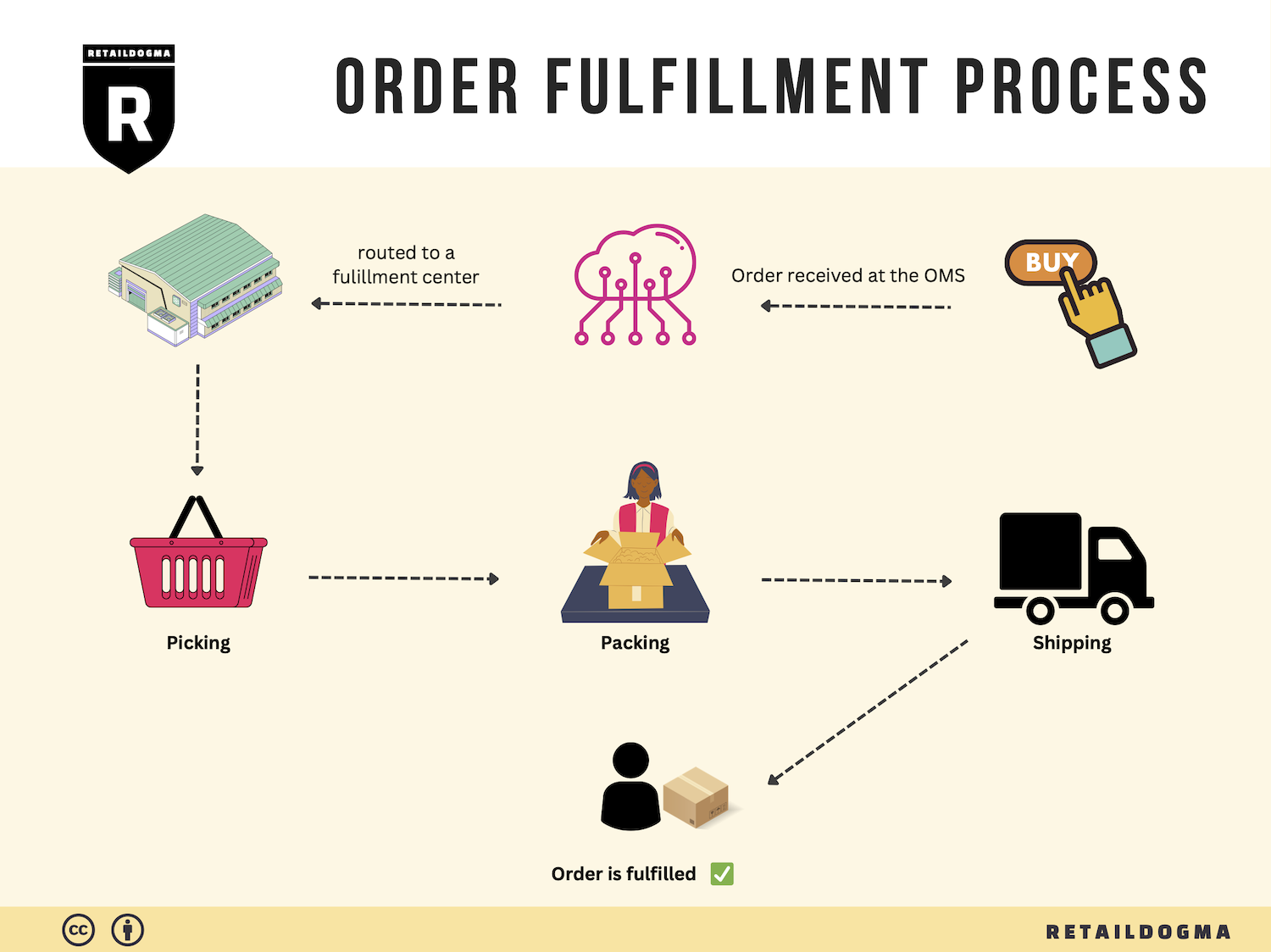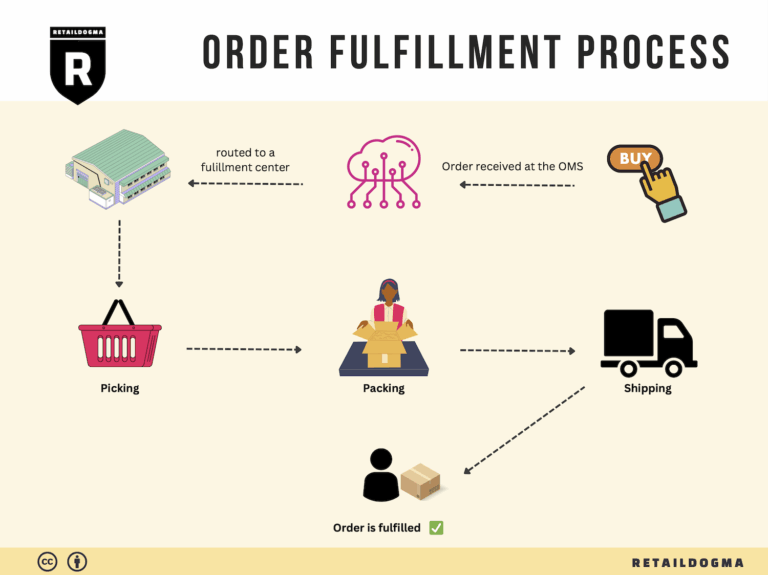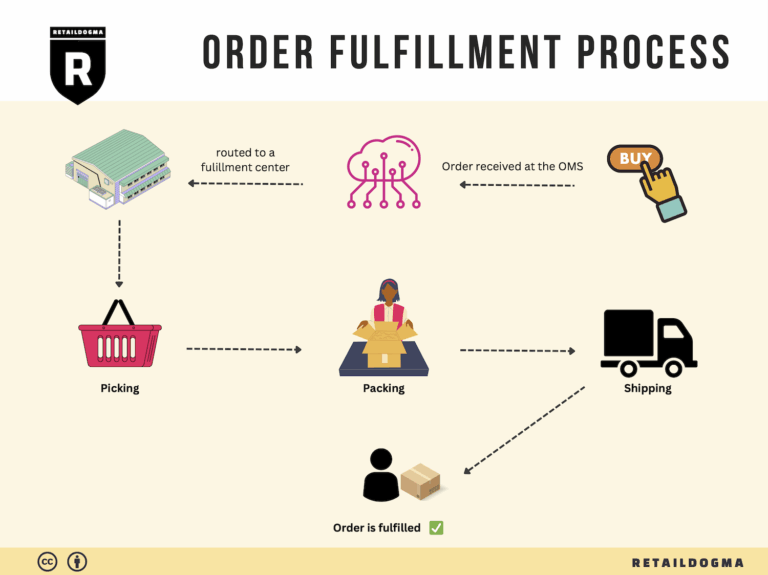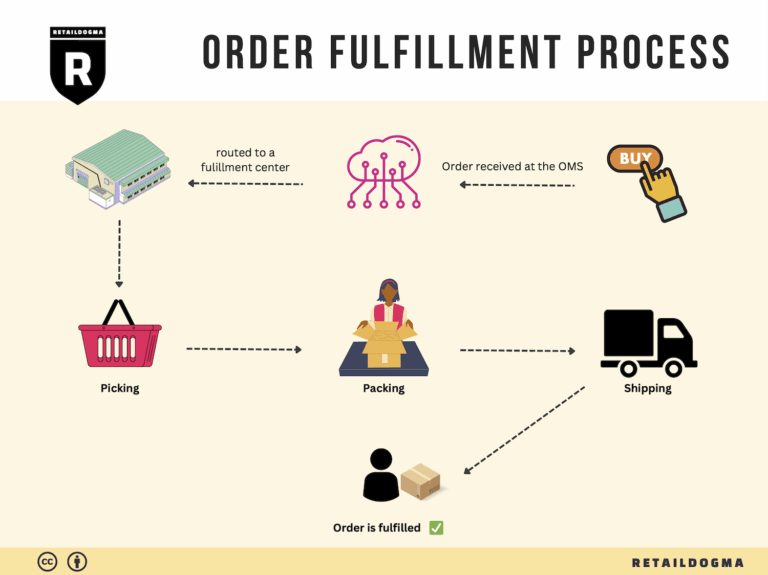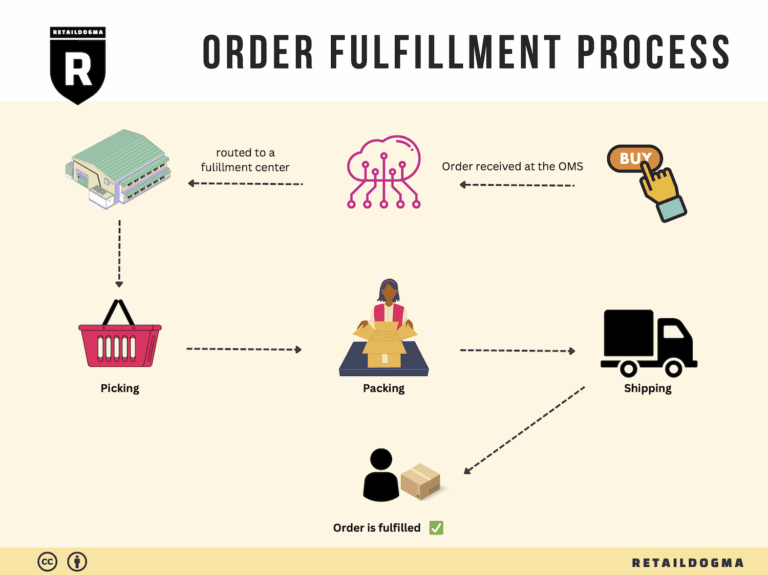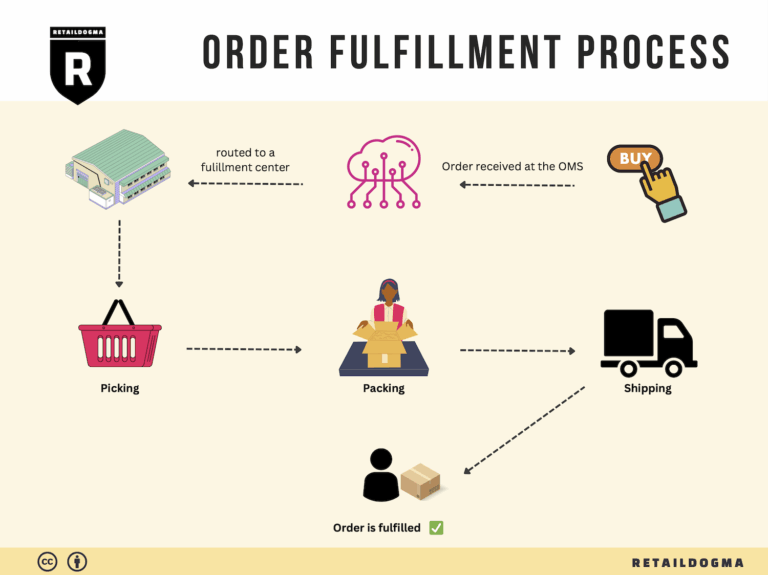Ecommerce Fulfillment Services: The Ultimate Guide (2025)
What is E-commerce Fulfillment? An Introduction for Growing Businesses
Understanding E-commerce Fulfillment: A Vital Component for Growth
As an e-commerce business owner, you may find yourself grappling with the overwhelming task of packing and shipping orders. Managing logistics can quickly become a daunting challenge, especially as your sales volume increases. This is where e-commerce fulfillment comes into play. At its core, fulfillment refers to the entire process of getting a product from your warehouse to your customer’s doorstep. It encompasses everything from inventory management and order processing to packaging and shipping.
For growing businesses, understanding the nuances of fulfillment is crucial. With various models available, such as Third-Party Logistics (3PL) and Fulfillment by Amazon (FBA), it’s essential to identify which approach aligns best with your operational needs and growth objectives. Each model has its strengths and weaknesses, and the right choice can significantly impact your efficiency and customer satisfaction.
This guide aims to delve into the various facets of e-commerce fulfillment, equipping you with the knowledge to make informed decisions. We will explore the core services that fulfillment partners typically offer, including:
- Inventory Management: Techniques for tracking stock levels and ensuring you have the right products available when customers place orders.
- Order Fulfillment: Understanding the order processing workflow, from receiving orders to shipping them efficiently.
- Returns Processing: Streamlining the returns experience to enhance customer satisfaction and maintain inventory integrity.
Additionally, we will discuss how to choose the right fulfillment partner. Factors such as reliability, efficiency, transparency, and flexibility should be considered when evaluating potential logistics providers. A partner that understands your unique business needs can help alleviate operational headaches and allow you to focus on scaling your sales.
Pricing is another critical component of the fulfillment equation. We will break down various pricing structures so you can better understand the costs associated with different fulfillment options, ensuring you can budget effectively as you scale your business.
Ultimately, the goal of this guide is to empower you with the insights needed to navigate the complexities of e-commerce fulfillment confidently. By making informed decisions about your logistics strategy, you can enhance your operational efficiency, improve customer satisfaction, and position your business for sustained growth.
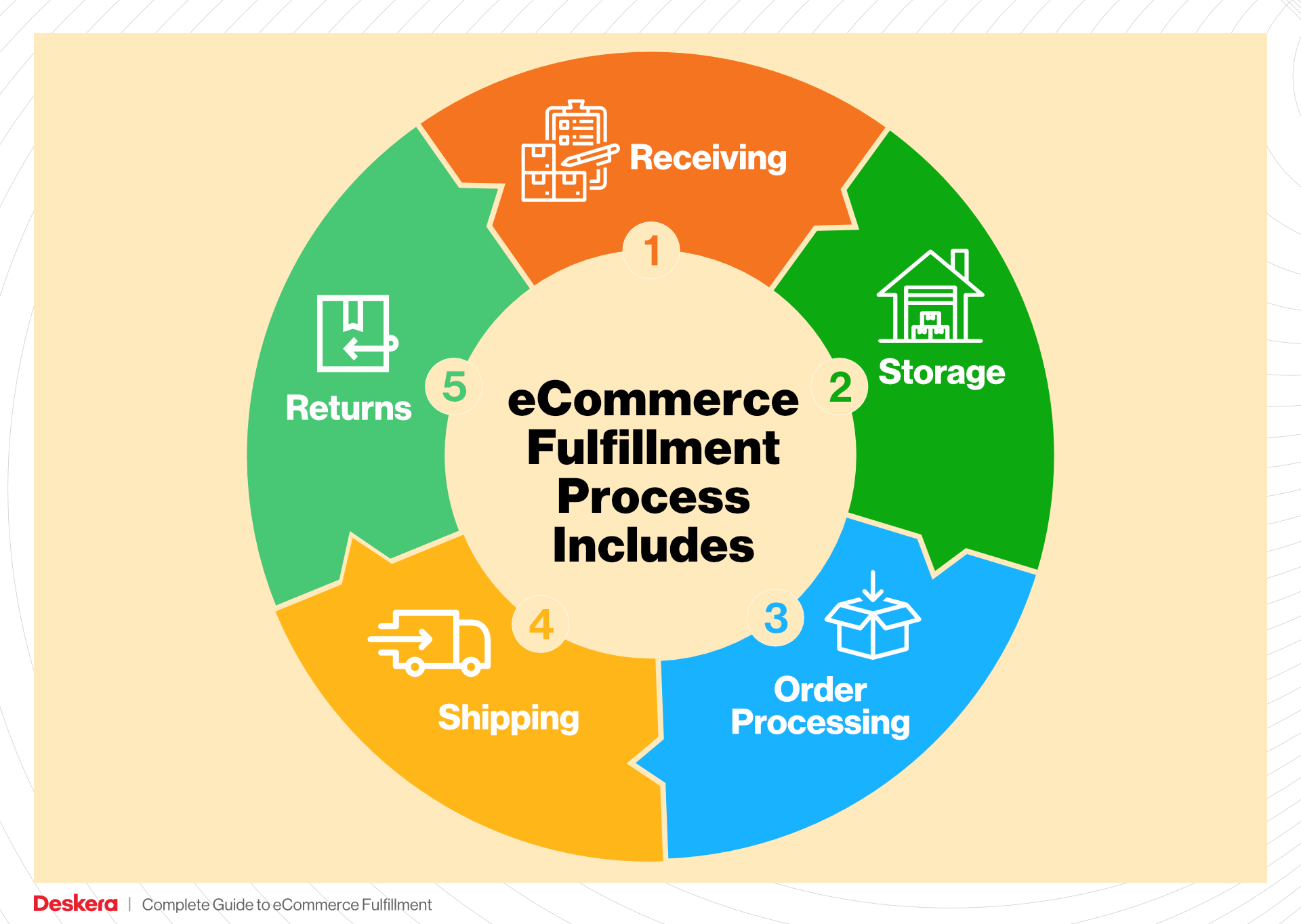
What You’ll Learn In This Guide
- What is E-commerce Fulfillment? An Introduction for Growing Businesses
- The Order Fulfillment Process: From ‘Buy’ Button to Customer’s Door
- Comparing Fulfillment Models: In-House vs. 3PL vs. Dropshipping
- A Deep Dive into Amazon FBA: Pros, Cons, and Who It’s For
- Core Services Offered by Fulfillment Centers
- How to Choose a Fulfillment Partner: A 6-Point Checklist
- Understanding Fulfillment Pricing: A Breakdown of Common Fees
- Frequently Asked Questions (FAQs) about Fulfillment
- Conclusion: Is Outsourcing Fulfillment the Right Move for Your Business?
- Important Disclaimer
The Order Fulfillment Process: From ‘Buy’ Button to Customer’s Door
1. Receiving Inventory
The order fulfillment process begins with receiving inventory at the fulfillment center. When products arrive, they are checked against purchase orders to ensure accuracy. This step involves inspecting the condition of the goods and updating inventory records to reflect new stock levels.
Why It’s Important: Proper receiving processes prevent discrepancies in inventory and ensure that your business has the correct quantities on hand to meet customer demand. Accurate inventory tracking is vital for maintaining sales and customer satisfaction.
Key Term: SKU (Stock Keeping Unit) – This unique identifier helps track products through the entire fulfillment process, facilitating accurate inventory management.
2. Warehouse Storage
Once inventory is received and logged, the next step is warehouse storage. Products are organized and stored in designated locations within the warehouse. Effective storage strategies may involve categorizing items by size, type, or sales velocity to streamline future picking processes.
Why It’s Important: Efficient warehouse storage maximizes space and minimizes the time required to retrieve products for orders. It also helps maintain an organized environment, reducing the risk of errors during order fulfillment.
Key Term: FIFO (First In, First Out) – This inventory management principle ensures that older stock is sold first, reducing the risk of product obsolescence and spoilage, particularly for perishable goods.
3. Order Picking
The third step in the order fulfillment process is order picking, where items are selected from their storage locations to fulfill customer orders. This can be done manually or with the assistance of technology such as barcode scanners or automated picking systems. The warehouse team uses pick lists—documents that outline the items and quantities needed for each order—to guide them through the picking process.

Why It’s Important: Accurate order picking is critical for ensuring that customers receive the correct products. Errors in this stage can lead to returns, negative customer experiences, and increased operational costs.
Key Term: Pick Lists – These lists are essential tools that detail which items need to be retrieved for each order, helping to streamline the picking process and reduce errors.
4. Order Packing
After items are picked, the next step is order packing. This involves carefully packaging the products to protect them during transit. The packing process may include selecting appropriate packaging materials, labeling parcels, and including necessary documentation, such as invoices or return instructions.
Why It’s Important: Proper packing minimizes the risk of damage during shipping, ensuring that customers receive their orders in excellent condition. Additionally, well-packed orders enhance the unboxing experience, contributing to customer satisfaction and brand loyalty.
Key Term: Packing Slip – This document details the contents of the package and is typically included inside the shipment. It serves as a confirmation for the customer and aids in inventory tracking.
5. Shipping & Delivery
The final step in the order fulfillment process is shipping and delivery. Once packages are packed, they are handed over to carriers for distribution. This step includes choosing the right shipping method based on cost, speed, and customer preferences. Monitoring shipment status and providing tracking information to customers are also vital components of this phase.
Why It’s Important: Timely and reliable shipping is crucial for maintaining customer satisfaction. The shipping process directly impacts the customer’s perception of your brand and influences repeat purchases.
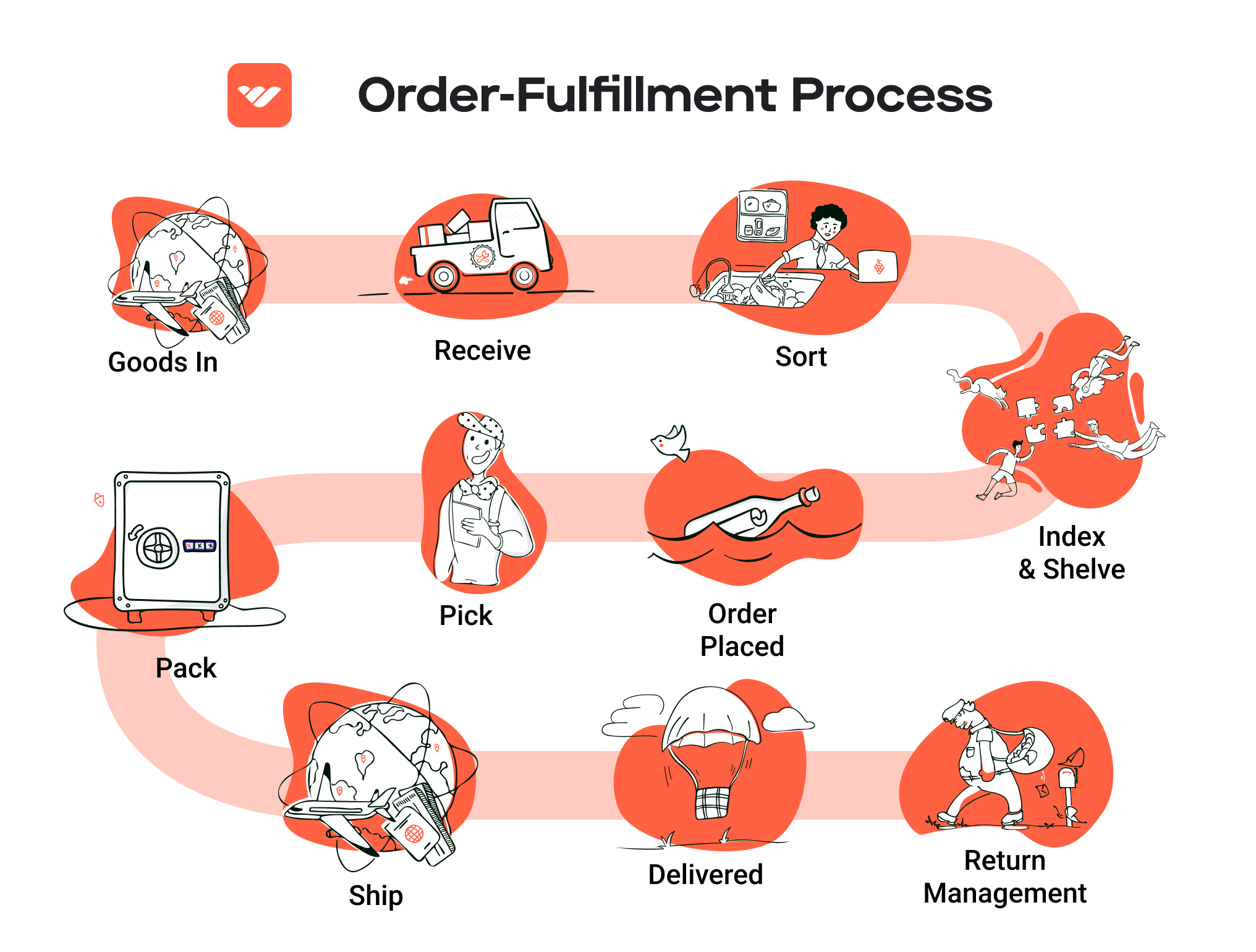
Key Term: Last-Mile Delivery – This term refers to the final step of the shipping process, where packages are delivered from a distribution center to the customer’s doorstep. Optimizing last-mile delivery can significantly enhance overall fulfillment efficiency.
By understanding and optimizing each step in the order fulfillment process, e-commerce businesses can enhance operational efficiency, improve customer satisfaction, and ultimately scale their logistics to support growth. Partnering with a reliable third-party logistics (3PL) provider like Webster Fulfillment can further streamline these processes, allowing you to focus on scaling your business effectively.
Comparing Fulfillment Models: In-House vs. 3PL vs. Dropshipping
Fulfillment Model Comparison Table
| Model | Who Handles Inventory | Best For (Business Stage) | Key Advantage | Key Disadvantage |
|---|---|---|---|---|
| In-House Fulfillment | Business owner or internal team | Established businesses with stable sales | Full control over inventory and processes | High overhead costs and resource demands |
| Third-Party Logistics (3PL) | 3PL provider | Startups and growing businesses | Scalable and flexible solutions | Less direct control over fulfillment |
| Dropshipping | Supplier | New businesses or those testing markets | Low upfront investment and risk | Lower profit margins and potential quality issues |
In-House Fulfillment
In-house fulfillment refers to managing the entire logistics process internally within your business. This model is best suited for established companies with consistent sales volumes that can justify the investment in warehousing, staff, and technology. The primary advantage of in-house fulfillment is the complete control it offers over inventory management, order processing, and shipping. This allows businesses to tailor their processes to their specific needs, maintain quality standards, and provide personalized customer service. However, this model comes with significant disadvantages, including high overhead costs associated with maintaining a warehouse, hiring staff, and managing logistics. Additionally, as order volumes fluctuate, businesses may find it challenging to scale operations efficiently without incurring additional costs.
Third-Party Logistics (3PL)
Utilizing a Third-Party Logistics provider, such as Webster Fulfillment, allows businesses to outsource their fulfillment needs to experts in the field. This model is particularly beneficial for startups and growing businesses that may not yet have the resources or infrastructure to manage fulfillment in-house. The key advantage of partnering with a 3PL is the scalability and flexibility it offers. As your business grows, a 3PL can quickly adjust to your needs, providing additional warehousing space, technology, and logistics support without the burden of managing these resources internally. Moreover, 3PL providers often have established relationships with carriers, enabling businesses to benefit from competitive shipping rates and faster delivery times. On the downside, businesses relinquish a degree of control over their fulfillment processes, which can lead to potential misalignment in service levels or customer experience if not managed carefully.
Dropshipping
Dropshipping is a fulfillment model where the retailer does not keep products in stock but instead transfers customer orders directly to a supplier who ships the products directly to the customer. This model is particularly appealing for new businesses or those looking to test markets without significant upfront investment. The key advantage of dropshipping is its low barrier to entry; entrepreneurs can start selling products without the need for inventory or warehousing, which minimizes financial risk. Additionally, it allows businesses to offer a wide variety of products without the constraints of physical storage. However, dropshipping also presents challenges, primarily related to profit margins and quality control. Retailers typically face lower margins as they rely on suppliers for fulfillment, and any issues with product quality or shipping times can negatively impact the retailer’s reputation. Furthermore, limited control over inventory can lead to stockouts or delays, affecting customer satisfaction.
Conclusion
When evaluating fulfillment models, e-commerce business owners must consider their unique circumstances, including their current business stage, resources, and long-term goals. In-house fulfillment offers control but at a high cost, while 3PL provides a scalable solution with expert support. Dropshipping presents a low-risk entry point but may compromise profit margins and quality. Ultimately, the choice of fulfillment model will significantly impact operational efficiency and customer satisfaction, making it essential to weigh the pros and cons carefully.
A Deep Dive into Amazon FBA: Pros, Cons, and Who It’s For
Understanding Fulfillment by Amazon (FBA)
Fulfillment by Amazon (FBA) is a service provided by Amazon that allows sellers to store their products in Amazon’s fulfillment centers. Amazon takes care of storage, packaging, and shipping, as well as customer service and returns for these products. This service enables sellers to leverage Amazon’s vast logistics network and customer base, providing a streamlined way to manage inventory and fulfill orders.
How FBA Works
-
Setup: Sellers create an Amazon seller account and enroll in the FBA program. They list their products on Amazon and prepare them for shipment to Amazon’s fulfillment centers.
-
Inventory Storage: Once the products arrive at the fulfillment center, Amazon stores them until a customer places an order. Sellers can track their inventory levels through their Amazon seller dashboard.
-
Order Processing: When a customer places an order, Amazon picks, packs, and ships the product on behalf of the seller. This process is handled by Amazon’s trained workforce, ensuring efficient handling and delivery.
-
Customer Service: Amazon manages all aspects of customer service for FBA orders, including inquiries and returns. This allows sellers to focus on other aspects of their business.
-
Returns Management: If a customer wants to return an item, Amazon processes the return and manages the logistics of getting the item back to the fulfillment center.
Pros of Fulfillment by Amazon (FBA)
1. Prime Eligibility
One of the most significant advantages of FBA is that products are eligible for Amazon Prime. This gives sellers access to millions of Prime members who prefer to shop for products that offer free two-day shipping. Being part of the Prime program can significantly boost sales and visibility on the platform.
2. Enhanced Customer Trust
Amazon is a trusted brand, and when sellers use FBA, their products are associated with that trust. Customers often feel more confident purchasing items fulfilled by Amazon due to the company’s strong reputation for customer service and reliability.
3. Multi-Channel Fulfillment
FBA allows sellers to fulfill orders not only from Amazon but also from other sales channels. Sellers can integrate their FBA inventory with their own websites and other marketplaces, streamlining operations and consolidating logistics under one fulfillment network.
4. Scalability
FBA enables sellers to scale their businesses without the need for significant investment in warehousing or logistics infrastructure. As demand increases, sellers can easily send more inventory to Amazon’s fulfillment centers without worrying about storage limitations.
5. Focus on Core Business Activities
With Amazon handling logistics, customer service, and returns, sellers can concentrate on marketing, product development, and growing their business rather than getting bogged down in operational details.
Cons of Fulfillment by Amazon (FBA)
1. High Fees
FBA comes with various fees, including storage fees, fulfillment fees, and additional costs for returns processing. These fees can add up quickly, especially for sellers with lower-margin products, potentially eating into profits.
2. Strict Inventory Rules
Amazon has stringent inventory management policies, including limits on the amount of inventory that can be stored at fulfillment centers. Sellers must carefully manage their stock levels to avoid penalties and ensure they do not run out of stock.
3. Commingling Risks
FBA products can be commingled, meaning that inventory from different sellers can be stored together. This raises risks for sellers, as they may receive returns or defective products that were not originally theirs. This can lead to quality control issues and customer dissatisfaction.
4. Loss of Control
When using FBA, sellers relinquish some control over their inventory and fulfillment processes. This can lead to challenges in ensuring that products are packaged and shipped according to the seller’s specifications.
5. Complex Returns Process
While Amazon manages returns, the process can be complex for sellers. Returns can impact inventory levels and require sellers to track returned items, which may lead to discrepancies in inventory management.
Who is FBA Best For?
Fulfillment by Amazon is particularly beneficial for:
-
Small to Medium-Sized Businesses: Companies that may not have the resources to manage their own logistics can benefit from FBA’s comprehensive services, allowing them to compete with larger retailers.
-
Sellers with High-Volume Products: Businesses with products that have a high turnover rate can take advantage of FBA’s ability to handle large quantities of inventory and quick shipping.
-
E-commerce Entrepreneurs: Startups looking to enter the online marketplace can leverage FBA to establish their brand without the overhead costs of warehousing and logistics.
-
Brands Seeking to Build Trust: Sellers wanting to establish credibility and trust among customers can benefit from the association with Amazon’s reputation.
-
Multi-Channel Sellers: Businesses that sell across multiple platforms and want a streamlined logistics solution can utilize FBA to manage fulfillment for various sales channels.
In conclusion, Fulfillment by Amazon offers a powerful tool for e-commerce sellers looking to simplify their logistics and scale their operations. While it presents certain challenges, the benefits of Prime eligibility, customer trust, and operational efficiency make it a compelling choice for many businesses.
Core Services Offered by Fulfillment Centers
Inventory Management & Warehousing
Inventory management is a critical component of any e-commerce operation. Fulfillment centers like Webster Fulfillment provide sophisticated inventory management solutions that help businesses keep track of stock levels, product locations, and order statuses in real-time. This service includes advanced technology systems that monitor inventory counts and automatically update records when items are sold or received.
Benefits:
– Real-time Visibility: E-commerce businesses gain immediate access to accurate inventory levels, reducing the risk of stockouts or overstocking, which can tie up capital.
– Efficient Space Utilization: Proper warehousing solutions optimize storage space, ensuring that products are stored in an organized manner for quick retrieval.
– Scalability: As businesses grow, fulfillment centers can easily adjust their warehousing solutions to accommodate increased inventory without the need for businesses to invest in additional storage facilities.
Pick and Pack Services
Pick and pack services are at the heart of order fulfillment. This process involves selecting items from inventory (picking) and preparing them for shipment (packing). Fulfillment centers utilize automated systems and skilled personnel to ensure that orders are picked accurately and packed efficiently.
Benefits:
– Speed and Accuracy: With a dedicated team focused on order fulfillment, e-commerce businesses can ensure that orders are processed swiftly, leading to faster shipping times and improved customer satisfaction.
– Customization: Many fulfillment centers offer customizable packing solutions, including branded packaging options, which can enhance the customer experience and reinforce brand identity.
– Reduced Operational Burden: By outsourcing pick and pack operations, businesses can free up internal resources and focus on other areas, such as marketing and product development.
Kitting and Assembly
Kitting and assembly services involve bundling multiple products into a single package or preparing items for sale. This service is particularly useful for businesses that offer product bundles or require certain items to be assembled before shipping.
Benefits:
– Increased Sales Opportunities: By offering bundled products, businesses can encourage customers to purchase more items at once, thereby increasing average order value.
– Time Savings: Outsourcing kitting and assembly allows businesses to save time and reduce labor costs associated with preparing products for sale.
– Improved Product Presentation: Fulfillment centers ensure that products are assembled and packaged professionally, enhancing the presentation and appeal of the final product to customers.
Returns Management (Reverse Logistics)
Returns management, or reverse logistics, is a critical service provided by fulfillment centers to handle the return of products from customers. This process involves inspecting returned items, restocking them, and managing the logistics of returns efficiently.
Benefits:
– Customer Satisfaction: A streamlined returns process can significantly enhance customer satisfaction, as it makes it easier for customers to return unwanted or defective items without hassle.
– Quality Control: Fulfillment centers inspect returned items to ensure they meet quality standards before being reintroduced to inventory, helping maintain product integrity.
– Operational Efficiency: By outsourcing returns management, businesses can focus on their core operations while ensuring that returns are handled efficiently and effectively.
Conclusion
In today’s competitive e-commerce landscape, the services offered by fulfillment centers are indispensable for businesses looking to scale operations and enhance customer satisfaction. By leveraging inventory management, pick and pack services, kitting and assembly, and returns management, e-commerce businesses can streamline their logistics processes, reduce operational burdens, and ultimately drive growth. Partnering with a reliable fulfillment center like Webster Fulfillment allows entrepreneurs to focus on their core business activities while ensuring that their logistics are in expert hands.
How to Choose a Fulfillment Partner: A 6-Point Checklist
Location & Warehouse Network
The geographical location of your fulfillment partner’s warehouses plays a critical role in determining shipping costs and delivery times. A strategically located network can significantly enhance your customer satisfaction by ensuring timely deliveries.
Key Questions to Ask:
– Where are your fulfillment centers located, and how do these locations align with my target market?
– Can you provide insights on your shipping times and costs to various regions?
– Do you have multiple warehouses to facilitate faster shipping during peak seasons?
Technology & Integrations
In today’s digital age, technology is a cornerstone of efficient fulfillment operations. Your partner should utilize advanced software for inventory management, order processing, and tracking. Seamless integration with your e-commerce platform is also crucial for real-time updates and operational efficiency.
Key Questions to Ask:
– What technology do you use for inventory management, and how does it provide real-time visibility?
– Can your system integrate with my existing e-commerce platform (e.g., Shopify, WooCommerce)?
– Do you offer APIs or plugins to facilitate data sharing and automation between our systems?
Specializations (e.g., Cold Storage, Oversized Items)
Different businesses have unique needs. If you sell perishable goods, bulky items, or require special handling, you need a fulfillment partner with the right capabilities. Understanding their specializations can help you avoid potential challenges down the line.
Key Questions to Ask:
– Do you offer specialized services such as cold storage or handling oversized items?
– What protocols do you have in place for managing sensitive products?
– Can you provide case studies or examples of handling products similar to mine?
Scalability & Capacity
As your business grows, your fulfillment needs will change. It’s essential to partner with a 3PL provider that can scale operations seamlessly to accommodate increased order volume without sacrificing service quality.
Key Questions to Ask:
– How do you handle fluctuations in order volume during peak seasons?
– What is your current capacity, and how quickly can you scale operations if needed?
– Can you provide examples of how you’ve supported businesses through growth phases?
Pricing and Contracts
Understanding the pricing structure and contract terms is vital to avoid unexpected costs. A transparent pricing model will help you budget effectively and assess the overall value of the partnership.
Key Questions to Ask:
– Can you provide a detailed breakdown of your pricing model (e.g., pick and pack fees, shipping costs)?
– What are the terms of your contracts, and do you offer flexibility in case my needs change?
– Are there any hidden fees I should be aware of (e.g., storage fees, return handling fees)?
Customer Support & Reviews
The level of customer support a fulfillment partner offers can significantly impact your operations. A responsive and knowledgeable support team can help resolve issues quickly, ensuring minimal disruption to your business. Additionally, reviewing testimonials and feedback from other clients can provide insights into their reliability.
Key Questions to Ask:
– What customer support options do you provide (e.g., phone, email, chat), and what are your response times?
– Can you share testimonials or case studies from similar businesses?
– How do you handle issues or disputes, and what is your escalation process?
Conclusion
Choosing the right fulfillment partner is a critical decision that can impact your e-commerce business’s efficiency and customer satisfaction. By following this checklist and asking the right questions, you can make an informed choice that aligns with your business goals and growth trajectory. Remember, the right partner will not only support your current needs but will also position you for future success.
Understanding Fulfillment Pricing: A Breakdown of Common Fees
Initial Setup Fees
Initial setup fees are typically charged when a new client starts using a fulfillment service. These fees cover the onboarding process, which may include integrating your e-commerce platform with the fulfillment center’s systems, setting up inventory management software, and configuring shipping settings. The costs can vary significantly based on the complexity of the integration and the number of products you have.
For example, if you have a straightforward setup with a few products, the fees may range from $100 to $500. However, for larger businesses with extensive product catalogs and multiple sales channels, setup fees can exceed $1,000. It’s crucial to discuss the specifics of your business with the fulfillment provider to understand what the setup will entail and to get a clear estimate.
Receiving Fees
Receiving fees are charged for the process of accepting and checking in inventory at the fulfillment center. This fee typically covers labor costs associated with unloading shipments, inspecting goods for quality, and entering them into the inventory management system.
Receiving fees can be calculated per hour of labor or based on the volume of goods received, such as per pallet or per box. For example, a fulfillment center may charge $25 to $50 per hour for labor or $5 to $15 per pallet received. It’s important to clarify how these fees are structured, as they can quickly add up, particularly during peak shipping seasons.
Storage Fees (per pallet/bin)
Storage fees are incurred for the space your inventory occupies within the fulfillment center. These fees are usually calculated on a monthly basis and can be charged per pallet, bin, or cubic foot, depending on the provider’s pricing model.
For instance, if you store inventory in a standard pallet, you might expect to pay between $10 and $30 per month per pallet. If your products require special handling or temperature-controlled environments, additional fees may apply. Understanding your storage needs and how they align with the provider’s pricing model will help you estimate these costs accurately.
Pick & Pack Fees (per item/order)
Pick and pack fees are charged for the service of selecting items from your inventory (picking) and packing them for shipment. This is a critical component of the fulfillment process, as it directly impacts order accuracy and customer satisfaction.
These fees can vary based on the number of items in each order or the complexity of the packing process. For example, you might pay $1 to $5 per item picked and packed, with discounts available for larger orders. Some fulfillment centers may also offer tiered pricing, where the cost per item decreases as order volume increases. It’s advisable to ask about any volume discounts to maximize your savings.
Shipping Fees
Shipping fees encompass the costs associated with transporting your products to customers. These fees can be one of the most variable components of fulfillment pricing, depending on factors such as package weight, dimensions, shipping speed, and destination.
Fulfillment centers typically charge shipping fees based on carrier rates (e.g., USPS, FedEx, UPS) plus a handling fee. For example, if shipping a standard package costs $10 through a carrier, the fulfillment center may add an additional handling fee of $2 to $5. It’s essential to understand the shipping options available and how they will impact your overall costs, especially if you plan to offer free shipping to customers.
Tips for Getting an Accurate Quote
-
Provide Detailed Information: When requesting a quote, be as detailed as possible about your business needs. Include information on your product types, average order volume, and any seasonal fluctuations in demand.
-
Ask About Additional Fees: Inquire about any potential additional fees that may not be included in the initial quote. This could include charges for returns processing, special packaging, or inventory audits.
-
Evaluate Customization Options: Some fulfillment providers offer customizable pricing models. Discuss your specific needs and explore whether a tailored solution could be more cost-effective for your business.
-
Compare Multiple Quotes: Don’t settle for the first quote you receive. Compare offers from different fulfillment providers to ensure you’re getting competitive pricing and services that align with your business goals.
-
Review the Contract Thoroughly: Before signing any agreements, review the contract closely to understand all fee structures and terms. This will help avoid any unexpected costs down the line.
By understanding the common fees associated with fulfillment services and asking the right questions, you can make informed decisions that will support the growth and efficiency of your e-commerce operations.
Frequently Asked Questions (FAQs) about Fulfillment
1. What is Webster Fulfillment?
Webster Fulfillment is a third-party logistics (3PL) provider specializing in comprehensive fulfillment services for e-commerce businesses. They offer tailored solutions including warehousing, inventory management, order processing, and shipping, designed to optimize supply chains and enhance operational efficiency for their clients.
2. What services does Webster Fulfillment offer?
Webster Fulfillment provides a wide range of services, including:
– Inventory Management: Real-time tracking and management of stock levels.
– Order Fulfillment: Efficient processing and shipping of customer orders.
– Returns Processing: Careful inspection and handling of returned items to ensure quality.
These services are customized to meet the unique needs of each business, ensuring a seamless fulfillment experience.
3. How does Webster Fulfillment ensure reliability?
Webster Fulfillment emphasizes reliability through a combination of experienced logistics professionals and advanced technology. Their systems provide real-time visibility into inventory and order status, while their dedicated team works diligently to ensure timely and accurate deliveries, thereby building trust and satisfaction among clients.
4. What is a 3PL?
A third-party logistics (3PL) provider is a company that offers outsourced logistics services, which can include warehousing, inventory management, order fulfillment, and shipping. By partnering with a 3PL like Webster Fulfillment, e-commerce businesses can focus on growth while leaving the complexities of logistics to experts.
5. What is the difference between a warehouse and a fulfillment center?
While both warehouses and fulfillment centers store goods, their functions differ significantly. A warehouse primarily focuses on storing products, often for long-term inventory management. In contrast, a fulfillment center is designed for efficient order processing and shipping, handling products with the goal of getting them to customers quickly and accurately.
6. How much do fulfillment services cost?
The cost of fulfillment services can vary widely based on factors such as order volume, storage needs, and specific service requirements. Webster Fulfillment offers customized pricing structures tailored to individual business needs, ensuring transparency and flexibility in costs.
7. Can Webster Fulfillment handle seasonal spikes in order volume?
Yes, Webster Fulfillment is equipped to handle seasonal fluctuations in order volume. Their flexible operational model allows for scalability, meaning they can ramp up resources and processes to accommodate increased demand during peak seasons without sacrificing service quality.
8. How can I track my inventory with Webster Fulfillment?
Webster Fulfillment provides clients with access to a user-friendly platform that offers real-time visibility into inventory levels. This allows businesses to monitor stock status, manage orders efficiently, and make informed decisions regarding restocking and inventory management.
9. What is the process for returns with Webster Fulfillment?
Webster Fulfillment simplifies the returns process by meticulously inspecting returned items to ensure they meet quality standards before being restocked. Their dedicated returns team manages the entire procedure, making it easy for businesses to handle customer returns efficiently and maintain satisfaction.
10. How do I get started with Webster Fulfillment?
To get started with Webster Fulfillment, interested businesses can request a quote through their website. A representative will then discuss specific needs, outline the available services, and tailor a fulfillment strategy that aligns with the business’s goals, ensuring a smooth onboarding process.
Conclusion: Is Outsourcing Fulfillment the Right Move for Your Business?
Assessing the Benefits of Outsourcing Fulfillment
Outsourcing fulfillment can be a transformative decision for e-commerce businesses aiming for growth and efficiency. By partnering with a reliable fulfillment service like Webster Fulfillment, you can save valuable time that would otherwise be spent managing logistics. This allows you to focus on what truly matters—growing your brand and expanding your market reach.
One of the most significant advantages of outsourcing fulfillment is scalability. As your business grows, so do your logistics needs. A dedicated fulfillment partner can easily accommodate fluctuations in order volume, ensuring that you can meet customer demand without the headache of managing additional warehouse space or staffing requirements. This flexibility is crucial in today’s fast-paced e-commerce environment.
Additionally, leveraging the expertise of a fulfillment service means you gain access to advanced logistics technology and industry best practices. This expertise can enhance your operations, streamline your processes, and ultimately improve customer satisfaction through timely and accurate deliveries.
However, the choice of a fulfillment partner is critical. Not all providers offer the same level of service or commitment to your business’s success. It’s essential to conduct thorough research and select a partner that aligns with your operational needs and growth objectives.
Take Action
As you consider whether outsourcing fulfillment is the right move for your business, take the time to audit your current shipping and logistics processes. Identify areas where you are experiencing bottlenecks, excessive costs, or inefficiencies. Evaluating these factors will provide clarity on whether a fulfillment partner like Webster Fulfillment could enhance your operational capabilities and drive your business forward. Don’t hesitate—transform your logistics strategy today for a more efficient and scalable tomorrow.
Important Disclaimer
⚠️ Important Disclaimer
The information in this guide is for educational purposes. Fulfillment services, pricing, and platform features change frequently. Always conduct your own due diligence and consult with providers directly before making business decisions.
